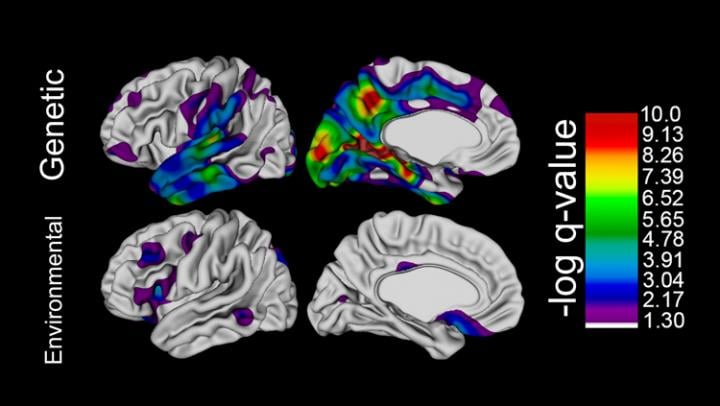Summary: Results provide new insight into evolution, IQ and development of the human brain.
Source: Society for Neuroscience
An analysis published in The Journal of Neuroscience of brain scans from more than 600 children and adolescents reveals genetically-mediated associations between the size of evolutionarily novel brain regions and intelligence test scores. Genetic influences on the brain follow the patterns of evolutionary expansion of the human brain relative to nonhuman primates.
Cerebral surface area has expanded dramatically over the course of human evolution. Brain regions that have undergone evolutionary expansion tend to follow a similar pattern during individual development. Despite these trends, brain structure can vary greatly between similar people. The relative contribution of genetic and environmental factors to individual differences in cerebral surface area in children has been unclear.
Eric Schmitt and colleagues found that more than 85 percent of individual differences in total cerebral surface area in their sample of twins and families could be attributed to genetic factors. The researchers also report that modest phenotypic correlations between surface area of the brain’s language centers and scores on standard intelligence tests are largely genetically-mediated. These findings suggest that evolutionary expansion of the human brain – and the cognitive abilities it supports – is largely under genetic control.

Source: Society for Neuroscience
Media Contact: David Barnstone – SFN
Publisher: Organized by Neuroscience News.
Image Source: NeuroscienceNews.com image is credited to Schmitt et al., JNeurosci (2019).
Original Research: Abstract for “A Comprehensive Quantitative Genetic Analysis of Cerebral Surface Area in Youth” by J. Eric Schmitt, Michael C. Neale, Liv S. Clasen, Siyuan Liu, Jakob Seidlitz, Joshua N. Pritikin, Alan Chu, Gregory L. Wallace, Nancy Raitano Lee, Jay N. Giedd and Armin Raznahan in The Journal of Neuroscience. Published March 4, 2019
doi:10.1523/JNEUROSCI.2248-18.2019
Funding:
This work was supported by National Institute of Mental Health grant MH-20030 and Big Data to Knowledge (BD2K) grant K01-ES026840 through the National Cancer Institute. The authors declare no competing financial interests.
Abstract
A Comprehensive Quantitative Genetic Analysis of Cerebral Surface Area in Youth
The genetics of cortical arealization in youth is not well understood. In this study, we use a genetically-informative sample of 677 typically-developing children and adolescents (mean age 12.72 years), high-resolution MRI, and quantitative genetic methodology in order to address several fundamental questions on the genetics of cerebral surface area. We estimate that over 85% of the phenotypic variance in total brain surface area in youth is attributable to additive genetic factors. We also observed pronounced regional variability in the genetic influences on surface area, with the most heritable areas seen in primary visual and visual association cortex. A shared global genetic factor strongly influenced large areas of the frontal and temporal cortex, mirroring regions that are the most evolutionarily novel in humans relative to other primates. In contrast to studies on older populations, we observed statistically significant genetic correlations between measures of surface area and cortical thickness (rG = 0.63), suggestive of overlapping genetic influences between these endophenotypes early in life. Finally, we identified strong and highly asymmetric genetically-mediated associations between Full-Scale Intelligence Quotient and left perisylvian surface area, particularly receptive language centers. Our findings suggest that spatially complex and temporally dynamic genetic factors are influencing cerebral surface area in our species.






